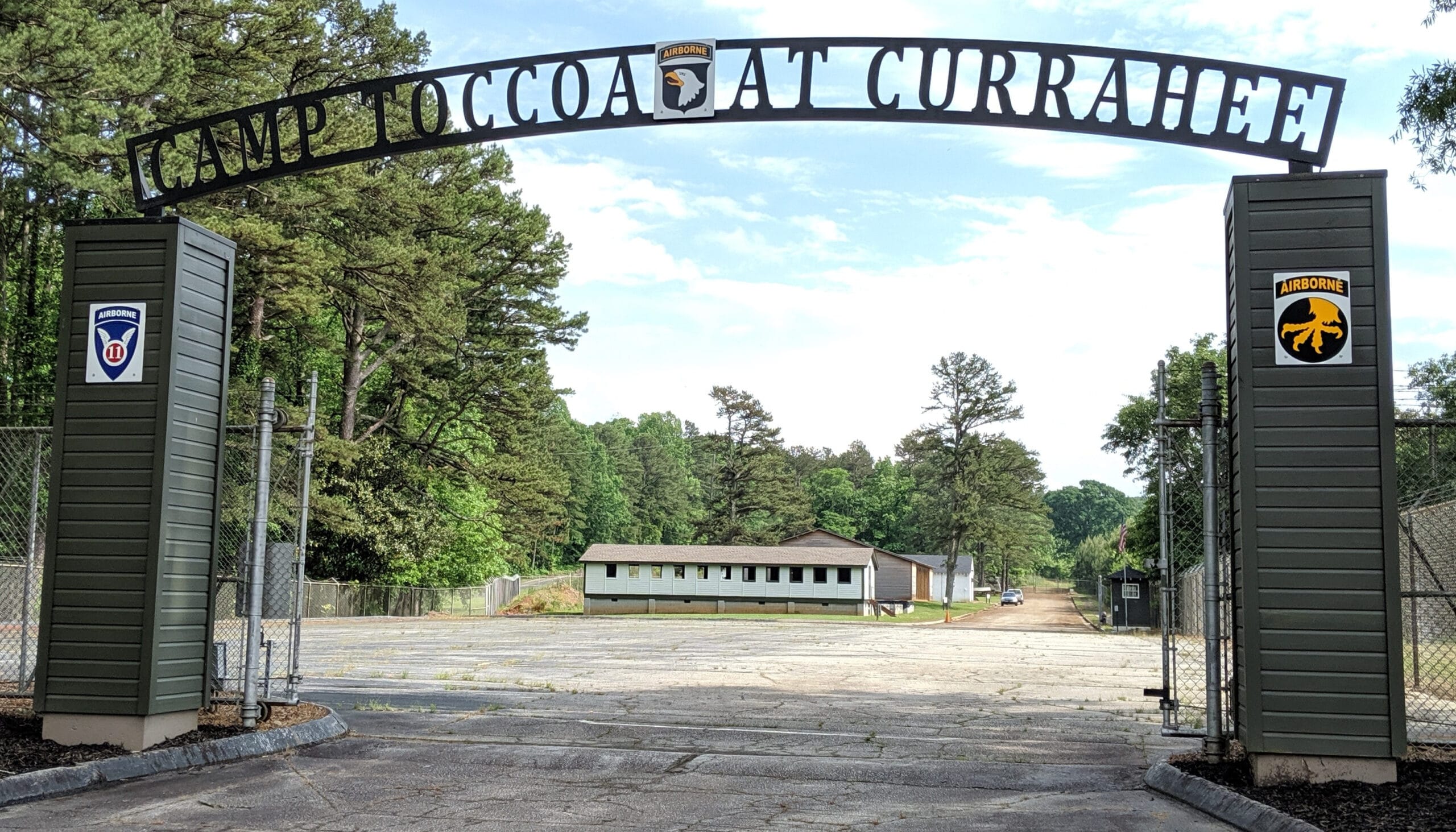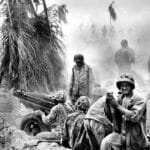Prepare to delve into the riveting history of Camp Toccoa, a place where ordinary young men transformed into the extraordinary paratroopers of the renowned 101st Airborne Division. More than just a training ground, Camp Toccoa was a crucible that forged the legendary “Toccoa Men,” leaving an indelible mark on the annals of World War II.
Forging Airborne Legends: The Toccoa Transformation
Nestled in the foothills of the Georgia mountains, Camp Toccoa stands as a testament to human resilience and the power of shared experience. During World War II, this seemingly ordinary landscape played a pivotal role in shaping the legendary 101st Airborne Division. Picture young men, many fresh out of their teens, arriving at Toccoa, likely a mix of nervous anticipation and apprehension. They were ordinary individuals about to embark on an extraordinary journey, one that would mold them into elite soldiers – the paratroopers.
Life at Camp Toccoa tested these men like never before. The training was arduous, designed to push them to their physical and mental limits. It was a crucible that broke them down and rebuilt them as warriors. Towering over the camp was Currahee Mountain, a formidable peak that became a symbol of their training. Day after day, rain or shine, they climbed, their voices echoing with the now-iconic chant, “Three miles up, three miles down!” This climb wasn’t simply about physical strength; it was about cultivating the mental toughness required to face the horrors of war.
Conquering Currahee was just one aspect of their transformation. These men also underwent rigorous parachute training, summoning the courage to leap from airplanes. They mastered weapons, from rifles and pistols to machine guns and explosives. Perhaps most importantly, they learned to function as a cohesive unit. The bonds forged at Toccoa, under immense pressure and shared hardship, would become unbreakable, essential for navigating the chaos of combat.
While the miniseries “Band of Brothers” brought the story of Easy Company to life, it’s crucial to remember that Camp Toccoa’s legacy extends far beyond a single company. Over 17,000 paratroopers trained there, men from diverse backgrounds united by their shared experiences. These “Toccoa Men” served with distinction in both the European and Pacific theaters of World War II, their contributions significantly impacting the war’s outcome. Their sacrifices must never be forgotten.
Preserving a Legacy: Camp Toccoa Today
After the war, Camp Toccoa closed its doors in 1946. However, the spirit of Toccoa and the legacy of the men who trained there lived on. Thanks to the dedication of the non-profit organization “Camp Toccoa at Currahee,” a significant portion of the camp has been meticulously restored. Today, visitors can step back in time, exploring the barracks where soldiers slept, the mess hall where they shared meals, and other buildings that once buzzed with activity.
The on-site Currahee Military Museum is a must-see, housing a treasure trove of artifacts, documents, and photographs that paint a vivid picture of life at Camp Toccoa. Visitors can see the uniforms worn, the letters sent home, and the equipment used in training and combat, offering a powerful and moving experience.
Camp Toccoa has become a pilgrimage site for veterans, their families, history enthusiasts, and individuals from around the globe. They come to pay their respects, walk in the footsteps of these courageous men, and connect with a pivotal piece of history. Hiking Currahee Mountain today allows visitors to experience a taste of the hardship and determination embodied by those who came before.
The chant “Three miles up, three miles down” transcends a simple motto; it’s a testament to the human spirit’s ability to overcome incredible challenges. The men of Camp Toccoa embody the values of honor, duty, and sacrifice. They faced the unknown with resilience and courage, leaving a legacy that continues to inspire. A visit to Camp Toccoa is a journey back in time, a chance to connect with history and honor the legacy of the Airborne legends forged on these hallowed grounds.
Was “Band of Brothers” Filmed at Toccoa?
The miniseries “Band of Brothers” vividly captures the grit and intensity of Easy Company’s journey. However, it wasn’t filmed at the actual Camp Toccoa. Instead, filmmakers chose locations in England, such as Hatfield Aerodrome and Hambleden village, to recreate the environments of World War II.
Despite not serving as a filming location, Camp Toccoa remains deeply significant to the real-life Easy Company narrative. It was here those soldiers were molded from ordinary men into the elite paratroopers depicted on screen.
Imagine: 1942. The United States Army requires a force capable of striking from the air. Camp Toccoa, nestled amidst the foothills of Georgia’s Blue Ridge Mountains, becomes the training ground for these airborne warriors.
Toccoa’s training was renowned for its brutality, pushing these men to their absolute limits. They faced challenges like the infamous “three miles up, three miles down” run up Currahee Mountain. This grueling climb transcended physical strength; it became a symbol of the paratroopers’ indomitable spirit, their refusal to yield to adversity.
Though they would later achieve fame through “Band of Brothers,” Easy Company’s story truly began in the sweat and struggle of Camp Toccoa. It was there the unbreakable bonds of brotherhood were forged, bonds that would see them through the horrors of war. Toccoa instilled in them an esprit de corps that would define their actions on D-Day and beyond.
Camp Toccoa stands as a powerful tribute to Easy Company and all the paratroopers who trained there. Though “Band of Brothers” wasn’t filmed on its grounds, the camp’s significance to the unit’s story remains immeasurable. It is a hallowed place where the spirit of these soldiers continues to inspire awe and respect.
Key Takeaways:
- Camp Toccoa was instrumental in transforming ordinary individuals into the highly skilled paratroopers of Easy Company.
- The demanding “three miles up, three miles down” run up Currahee Mountain became a testament to the paratroopers’ unwavering dedication and extraordinary resolve.
- Although not the filming location for “Band of Brothers,” Camp Toccoa remains deeply significant to the history of Easy Company.
- The camp serves as a solemn reminder of the sacrifices made by Easy Company’s paratroopers and stands as a testament to their enduring legacy.
Do People Still Run Currahee?
Currahee Mountain, forever linked to the “Band of Brothers” miniseries, continues to beckon runners to its challenging slopes. This isn’t just any mountain; it’s steeped in history, the very ground where the 101st Airborne Division pushed their limits during World War II. Camp Toccoa, nestled at the foot of Currahee, was their crucible, shaping these soldiers into the legends they became. So, do people still tackle this iconic climb? Absolutely.
The allure of Currahee extends beyond a tough workout. It’s a living tribute to the paratroopers who trained there, offering a tangible connection to their world. Runners, from seasoned athletes to those just starting out, test themselves against the same demanding terrain that forged the 101st. It’s a powerful link to history, a way to honor the past while challenging oneself in the present. This likely explains the enduring appeal of running Currahee, drawing individuals with both the physical challenge and the historical significance.
Camp Toccoa’s training regime was notoriously difficult, and Currahee played a key role. The mountain’s unforgiving ascent and descent – “3 miles up, 3 miles down” – became synonymous with their resilience. This constant push, this grueling climb, likely shaped not only their physical strength but also their mental fortitude, forging the unbreakable bonds that would define them in battle. Some historians suggest that the shared experience on Currahee contributed significantly to the unit’s cohesion and effectiveness in combat.
For those contemplating a Currahee run today, it’s more than checking off a fitness goal; it’s often described as a pilgrimage. Runners from around the globe retrace the steps of those paratroopers, pushing their limits while reflecting on the sacrifices made on those very slopes. It’s a challenging run, but one that offers a profound connection to the past.
If you’re considering tackling Currahee, preparation is paramount. While the trail is generally well-maintained, the steep incline and descent demand respect. Don’t underestimate the challenge. Allow ample time, pack plenty of water and snacks for sustained energy, and wear appropriate footwear. Upon reaching the summit, take a moment to absorb the breathtaking views and let it sink in: you’ve conquered Currahee. Imagine the paratroopers doing the same, their training preparing them for the battles to come.
Here are a few things to keep in mind for your Currahee run:
- Hydration and Nutrition: Carry more water than you anticipate needing, especially in warmer weather. Energy bars or gels can help maintain stamina during the climb.
- Pacing: Avoid starting too fast. The initial incline can be deceiving. Find a sustainable rhythm and remember that the descent can be equally challenging on your joints.
- Footwear: Trail running shoes with good grip are essential. The terrain can be uneven, and proper footwear will help prevent slips and injuries.
- Weather: Check the forecast before heading out. Conditions can change rapidly in mountainous areas. Be prepared for both sun and rain.
- Respect the History: Remember that Currahee is more than a mountain; it’s a memorial to the soldiers who trained there. Treat the trail and surrounding area with respect.
Currahee Mountain remains a powerful symbol of perseverance and sacrifice. Running it transcends mere exercise; it’s an experience, a chance to connect with history, challenge yourself, and gain a deeper understanding of the men who trained on those slopes. While the precise impact of Currahee’s training on the 101st Airborne is still being studied by historians, one thing remains certain: its legacy continues to inspire runners today. So, if you’re seeking a run that’s both physically demanding and historically enriching, Currahee might be the challenge you’re looking for.
What Does “Currahee” Mean in the Army?
We’ve touched upon the history surrounding Currahee, but let’s delve deeper into its significance for the army, particularly for the brave paratroopers of the 101st Airborne Division. It’s more than a mountain; it’s a symbol, a test, and a testament to their grit.
“Currahee,” a Cherokee word, translates to “stands alone.” Ponder that for a moment – “stands alone.” It’s a powerful image, incredibly fitting for the paratroopers who trained at Camp Toccoa at the base of this imposing mountain. These soldiers, preparing to jump from airplanes into enemy territory, were training for a level of solitude and self-reliance most of us can’t fathom. They were preparing to “stand alone” in the face of danger, and Currahee Mountain, in a way, became their first opponent.
Beginning in 1942, Camp Toccoa became a crucible where ordinary young men were forged into extraordinary soldiers. The 506th Parachute Infantry Regiment, whose stories were immortalized in the “Band of Brothers” miniseries, endured the intense training at Toccoa. Currahee Mountain played a starring role in their transformation.
This wasn’t just any mountain; it was a constant, looming presence, a daily test. The soldiers ran up and down its steep slopes, their legs burning, their lungs aching, carrying heavy packs that simulated combat gear. The weather, whether scorching heat or pouring rain, only amplified the difficulty. “Three miles up, three miles down” became more than a description; it became a mantra, a test of will, a shared experience that forged an unbreakable bond between them. Some might even say it became a shared suffering that forged an unbreakable connection between them.
Imagine yourself there, pushing your body to its limits day after day, with Currahee Mountain standing as a silent witness to your struggles and triumphs. Each step, each labored breath, brought them closer to becoming the elite soldiers they were destined to be. Some military historians suggest that the grueling runs weren’t solely about physical conditioning; they were about building mental toughness, about instilling the resilience essential for the battles to come. It was about proving to themselves, and to each other, that they could overcome any obstacle, no matter how daunting.
And overcome they did. The men who conquered Currahee went on to face unimaginable challenges – the beaches of Normandy on D-Day, the bitter cold and ferocious fighting of the Battle of the Bulge, the horrors of the concentration camps they helped liberate. Their courage, sacrifices, and ability to “stand alone” in the face of adversity became inextricably linked to the mountain that had tested their limits. Currahee evolved into a symbol not just of their training, but of their spirit, dedication, and ultimate triumph. It embodies the enduring legacy of the 101st Airborne Division, a legacy forged in sweat, determination, and the unwavering belief that they could conquer anything – even a mountain that “stands alone.”
Ongoing research into the experiences of the soldiers who trained at Camp Toccoa continues to reveal new insights and deepen our understanding of the impact Currahee Mountain had on their development. While we know much about the physical challenges they faced, we are still learning about the psychological impact of this demanding training. Some experts believe that the shared experience of conquering Currahee forged a powerful sense of camaraderie and unit cohesion, essential for their success in combat. Further research may shed more light on the long-term effects of this intense training and how it shaped the lives of these men in the years that followed.
Currahee Mountain is far more than a geographical landmark; it’s a symbol of resilience, courage, and the enduring spirit of the American soldier. It is a testament to the power of shared struggle, the unbreakable bonds forged in the face of adversity, and the enduring legacy of those who dared to “stand alone.”
Don’t miss our article on the strategic brilliance of Admiral Spruance, a key figure in the Pacific Theater during World War II.
- Unlock what part of speech is is: Master English Grammar Now - April 2, 2025
- Unlock the best US history books: A curated list for insightful reading - April 2, 2025
- First Lady Book: A History of Power and Influence - April 2, 2025

















1 thought on “Camp Toccoa: From Foot Soldiers to Airborne Legends – The Story of the 101st and Currahee Mountain”
Comments are closed.